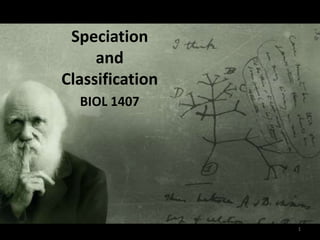
1407 speciation and classification
- 2. 2
- 3. Learning Objectives (Part I): • Describe the forces that lead to the evolution of new species • Define a biological species • Compare and contrast several forms of pre-zygotic and post-zygotic barriers to reproduction • Compare and contrast allopatric, sympatric, and parapatric speciation 3
- 4. What is a species? 4
- 5. Western Meadowlark Eastern Meadowlark https://www.youtube.com/watch?v=lv AUgFb1cLY https://www.youtube.com/watch?v =vDpydv6VbtU 5
- 6. 6
- 7. 7
- 9. 9
- 10. 10
- 11. 11
- 12. Biological Species Concept •1. •2. •3. Ernst Mayr 12
- 13. 13
- 15. Reproductive Barriers Cause Speciation Section 14.2 Figure 14.4 Prezygotic reproductive barriers = 15
- 16. Practice! 16
- 17. Reproductive Barriers Cause Speciation Section 14.2 Postzygotic reproductive barriers = Figure 14.4 17
- 18. Reproductive Barriers Cause Speciation Section 14.2 Figure 14.24 Stilts: ©Tim Fitzharris/Minden Pictures; Sperm: ©Francis Leroy, Biocosmos/Science Source; Chick: ©S. Alden/PhotoLink/Getty Images RF; Stilt: USDA Natural Resources Conservation Service 18
- 19. Spatial Patterns Define Three Types of Speciation Section 14.3 Figure 14.5 Reproductive barriers arise in three ways, depending on spatial patterns: 19
- 20. Spatial Patterns Define Three Types of Speciation Section 14.3 Figure 14.5 In allopatric speciation, a barrier physically separates a population into two groups that cannot interbreed. 20
- 21. Spatial Patterns Define Three Types of Speciation Section 14.3 Figure 14.7 For example, Galápagos tortoises diverged into several subspecies on different islands. Left & right tortoise: ©Tui De Roy/Minden Pictures 21
- 22. Spatial Patterns Define Three Types of Speciation Section 14.3 Figure 14.5 22
- 23. Spatial Patterns Define Three Types of Speciation Section 14.3 Figure 14.8 Parapatric speciation may be occurring in little greenbuls. 23
- 24. Spatial Patterns Define Three Types of Speciation Section 14.3 Figure 14.5 24
- 25. Spatial Patterns Define Three Types of Speciation Section 14.3 Figure 14.9 Cichlid fish have diversified into several species in a small African lake. 25
- 26. Spatial Patterns Define Three Types of Speciation Section 14.3 Figure 14.10 Sympatric speciation also occurs when gametes unite to form polyploid offspring with more chromosomes than either parent. 26
- 27. Learning Objectives (Part II): • Identify the proper way to name a biological species. • Name the levels of the taxonomic hierarchy from domain to species. • Use a cladogram to identify monophyletic, paraphyletic, and polyphyletic groups. • Use biological information to create a cladogram • Interpret a phylogenetic tree or cladogram to determine relationships between species 27
- 28. Naming species Carl von Linné AKA Carolus Linnaeus 1707-1778 28
- 29. Binomial nomenclature • 2-part name, Latinized Genus + specific epithet = Species name (scientific name) • Typed in Italics • Underlined when handwritten • Examples: Homo sapiens Homo neanderthalensis Canis lupus Canis latrans Crotalus atrox Crotalus horridus 29
- 31. Figure 14.15 Biological Classification Systems Are Based on Common Descent Section 14.6 The taxonomic hierarchy organizes species into progressively larger groups. 31
- 32. The lingo of the organization of life. Classification= 32
- 33. The lingo of the organization of life. Systematics= 33
- 34. The lingo of the organization of life. Taxonomy= 34
- 35. The lingo of the organization of life. Phylogeny= 35
- 36. 14-36 Phylogenetics is the study of evolutionary relationships among species Section 14.6 A phylogeny is an evolutionary tree. The most useful way to construct the phylogeny is to use the cladistic approach. Figure 14.17 Ancestral characters (for placental mammals): Features present in the ancestors of placental mammals; these features may also be present in monotremes and/or marsupials. Derived characters (for placental mammals): Features of placental mammals that are different from those in other mammals; arose after the placental/marsupial split. 36
- 37. The lingo of the organization of life. Cladistics= 37
- 38. Biological Classification Systems Are Based on Common Descent Section 14.6 Figure 14.17 A clade is a group of organisms consisting of a common ancestor and all of its descendants. Clades 38
- 39. 39
- 40. 40
- 41. A Cladogram Can Be Drawn in Several Ways Section 14.6 Figure 14.18 These cladograms all show the same evolutionary relationships. 41
- 42. Identifying Groups in Cladograms Section 14.6 Figure 14.21 A clade is also called a monophyletic group. 42
- 43. 43
- 44. Identifying Groups in Cladograms Section 14.6 Figure 14.21 A paraphyletic group excludes some of the descendants of an ancestor. See how birds are excluded from Class Reptilia? 44
- 45. Identifying Groups in Cladograms Section 14.6 Figure 14.21 A polyphyletic group excludes the most recent common ancestor of its members. Birds and mammals are endotherms, but their common ancestor was not endothermic. 45
- 46. Using Character Variation to Reconstruct Phylogeny • Reconstructing phylogeny requires determining ancestors and descendants. • The form that was present in the common ancestor is ancestral. • Characters that arose later are derived character states. • An outgroup shows if a character occurred both within and outside the common ancestor. • A series of species that share derived characters form a subset called a clade.
- 47. 14-47 Cladograms can be based on molecular sequences Section 14.6 This cladogram compares variations in DNA sequence. DNA can be obtained from living and extinct species, vastly increasing the amount of information that can be used. Figure 14.21 47
- 48. 48
- 49. 49
- 53. Table 14.1 53